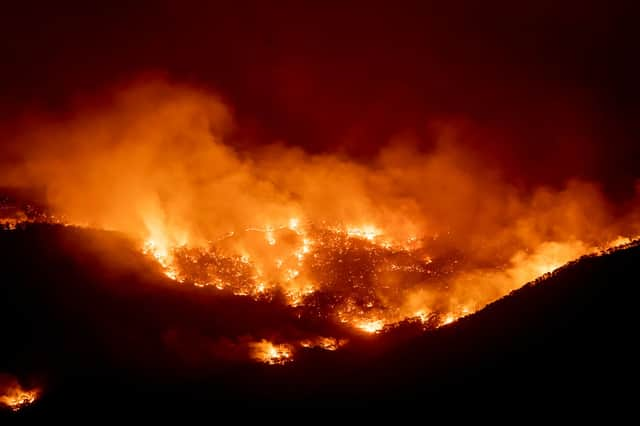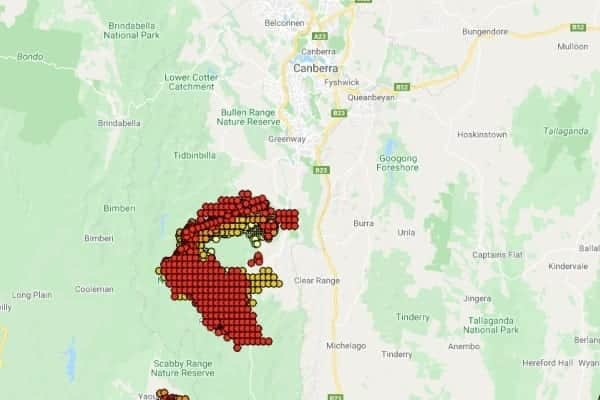Where the Canberra bush fires are today, weather forecast and latest travel advice


A state of emergency has been declared in the Australian Capital Territory (ACT), as massive bush fires rage south of Canberra.
Officials said the flames pose the worst fire threat to the territory in nearly two decades, and the main blaze is burning across an area of more than 18,500 hectares.
Advertisement
Hide AdAdvertisement
Hide Ad"The ACT is now facing the worst bush fire threat since the devastating fires of 2003," Chief Minister Andrew Barr told reporters on Friday.


"There's now no higher priority for the ACT government at this time than the bush fire threat."
Residents in the suburbs of Canberra, Australia's capital city, have been told to "remain alert" as orders of evacuation could come at any moment.
Roads were blocked to the village of Tharwa on Friday because the fire posed too much danger for residents to evacuate or return to their homes.
Advertisement
Hide AdAdvertisement
Hide AdAustralia remains in the clutches of one of its worst bush fire seasons on record.


Blazes have been sweeping through the country since September, killing 29 people, destroying 2,500 homes, and razing forests and farmlands to the ground. Land mass equivalent to Bulgaria has been devastated.
New South Wales, Victoria, and South Australia have seen the most disastrous effects of the fires, though other areas of the country have also been impacted.
Where are the fires?
The fires currently burning near Canberra (Photo: My Fire Watch)
Advertisement
Hide AdAdvertisement
Hide AdThe above map shows the extent of the fires burning near Canberra, with data taken from Australian government website MyFireWatch, which uses satellite data to map heat sources.
Note that the data incorporates "any heat source that is hotter than its surroundings."
"This may include gas flares, refinery furnaces or highly reflective large industrial roofs", according to the website.
That means that the symbols are not guaranteed to indicate actual fires. The hotspot symbols also do not represent the actual size of fires or the danger posed by them.
Advertisement
Hide AdAdvertisement
Hide AdThe fire is burning at emergency level - the highest on a three-tier scale of danger - and embers have created dangerous spot fires nearby, agency officials said.
What's the official travel advice?
"Australia continues to battle serious bush fires across multiple regions," say the Foreign Office in their official travel advice.
"Authorities in some regions have declared a State of Emergency and ordered road closures and evacuations.
"Poor air quality can occur some distance from the sites of the fires and provoke respiratory conditions.
Advertisement
Hide AdAdvertisement
Hide Ad"If you’re in or near an affected area or planning any travel, stay safe, monitor TV news, radio and social media channels for updates, and follow the instructions and advice of local authorities."
What's the weather forecast for Canberra?
A kangaroo jumps in a field amidst smoke from a bushfire (Photo: AF via Getty)
Unfortunately, the weather forecast for the area suggests that conditions maybe perfect for the further spread of the fires.
A hot, sticky and stormy weekend is in store, with small chance of any significant rainfall.
Advertisement
Hide AdAdvertisement
Hide AdHowever, with high levels of humidity, the "fire dangers should be capped at severe".
That's according to Dean Sgarbossa from Australia's Bureau of Meteorology, who told The Guardian that "there’s going to be unusually humid conditions that will feel almost like tropical humidity."
“It makes it hard for people to cool down. But despite those high temperatures, the fire dangers should be capped at severe, and that’s because of the humidity.”
Are the fires down to climate change?
Climate scientists warned that Australia's fires were a harbinger of what was to come for the rest of the world as the planet warmed due to human activity.
Advertisement
Hide AdAdvertisement
Hide Ad"Temperature conditions in Australia are extreme at the moment but they are what we expect to happen on average in a world of three degrees of global warming," said Richard Betts, Head of Climate Impacts Research at Britain's Met Office Hadley Centre.
"It brings it home to you what climate change means."
Mr Morrison welcomed the US. move to scale back its travel warning and said Australia was "very much open for business", amid concerns the fires would damage the tourism industry and the broader economy.